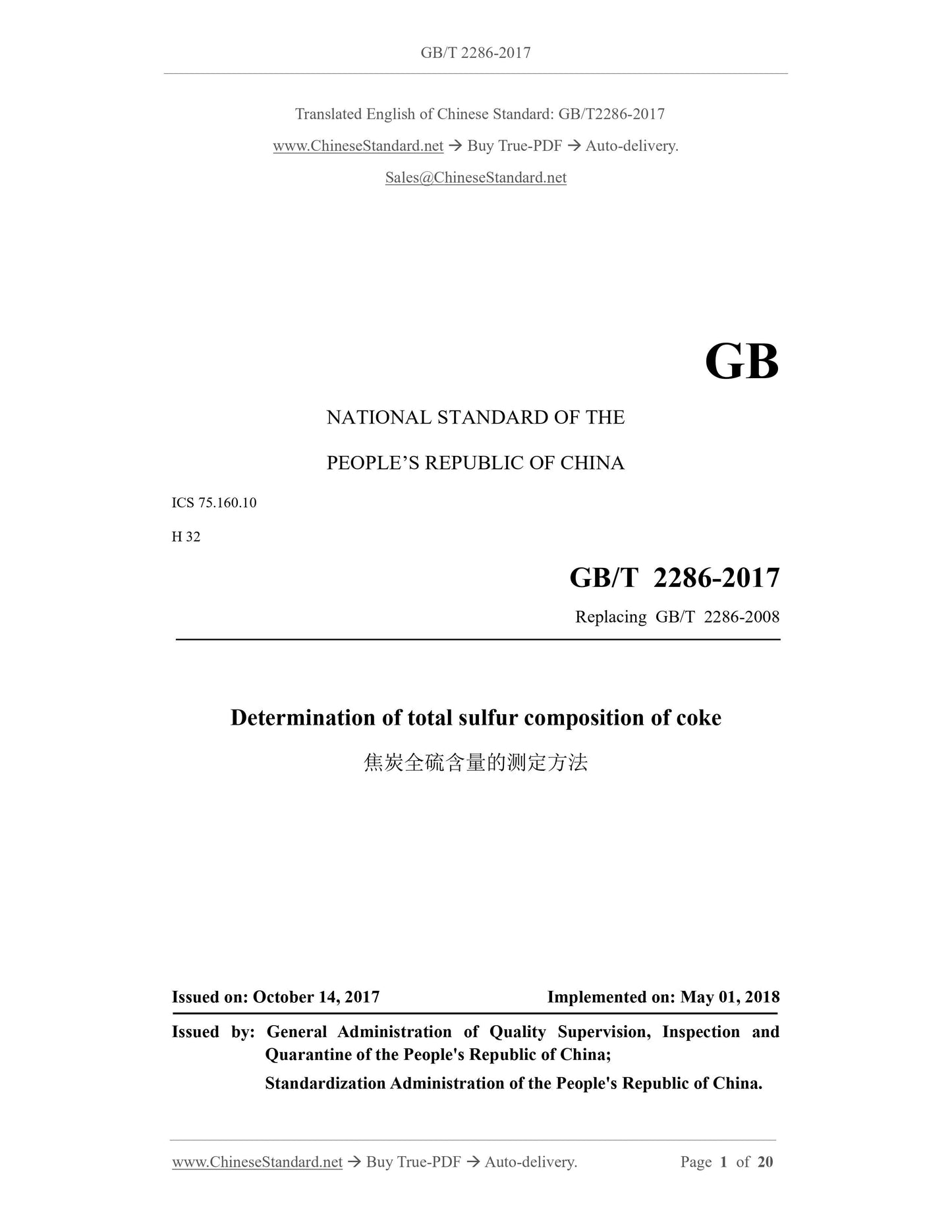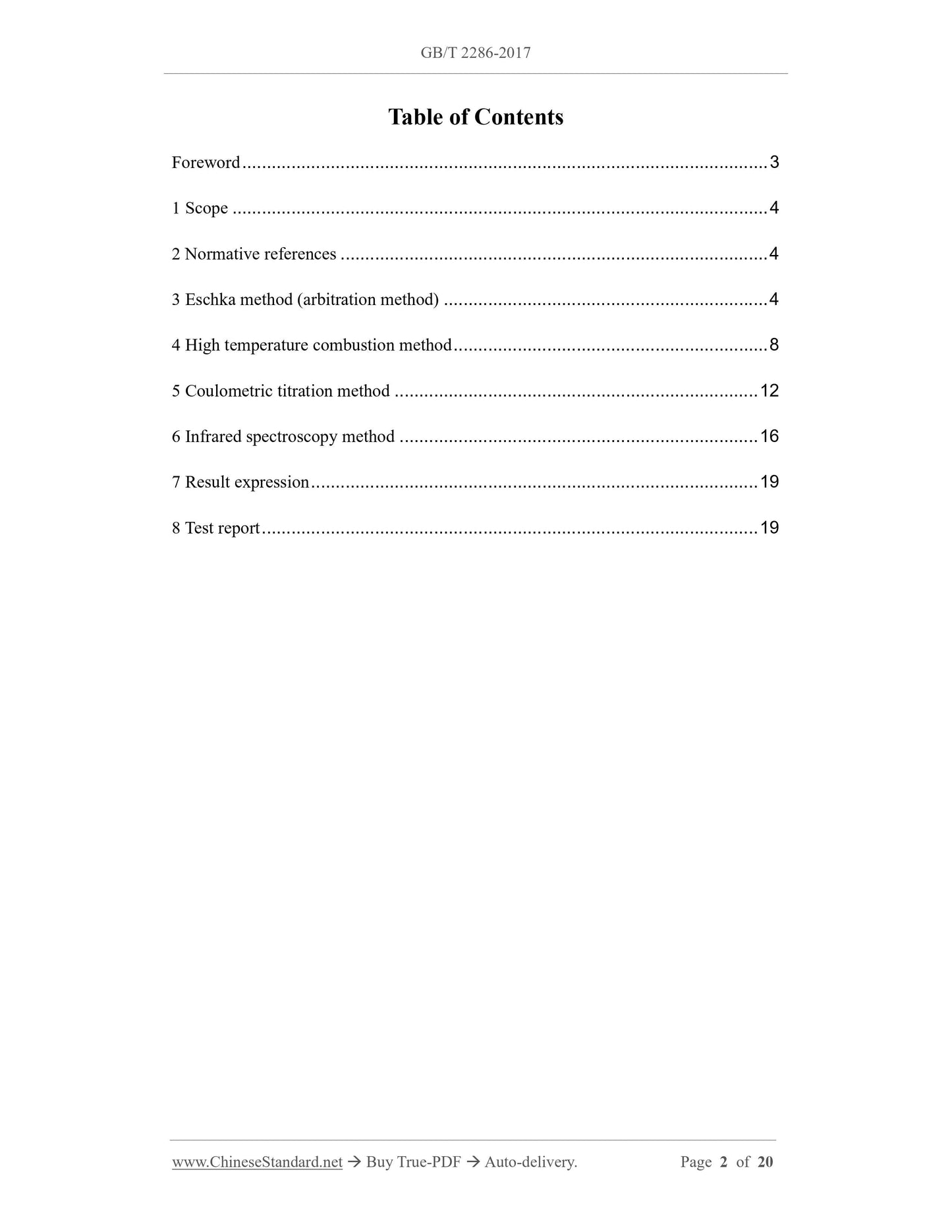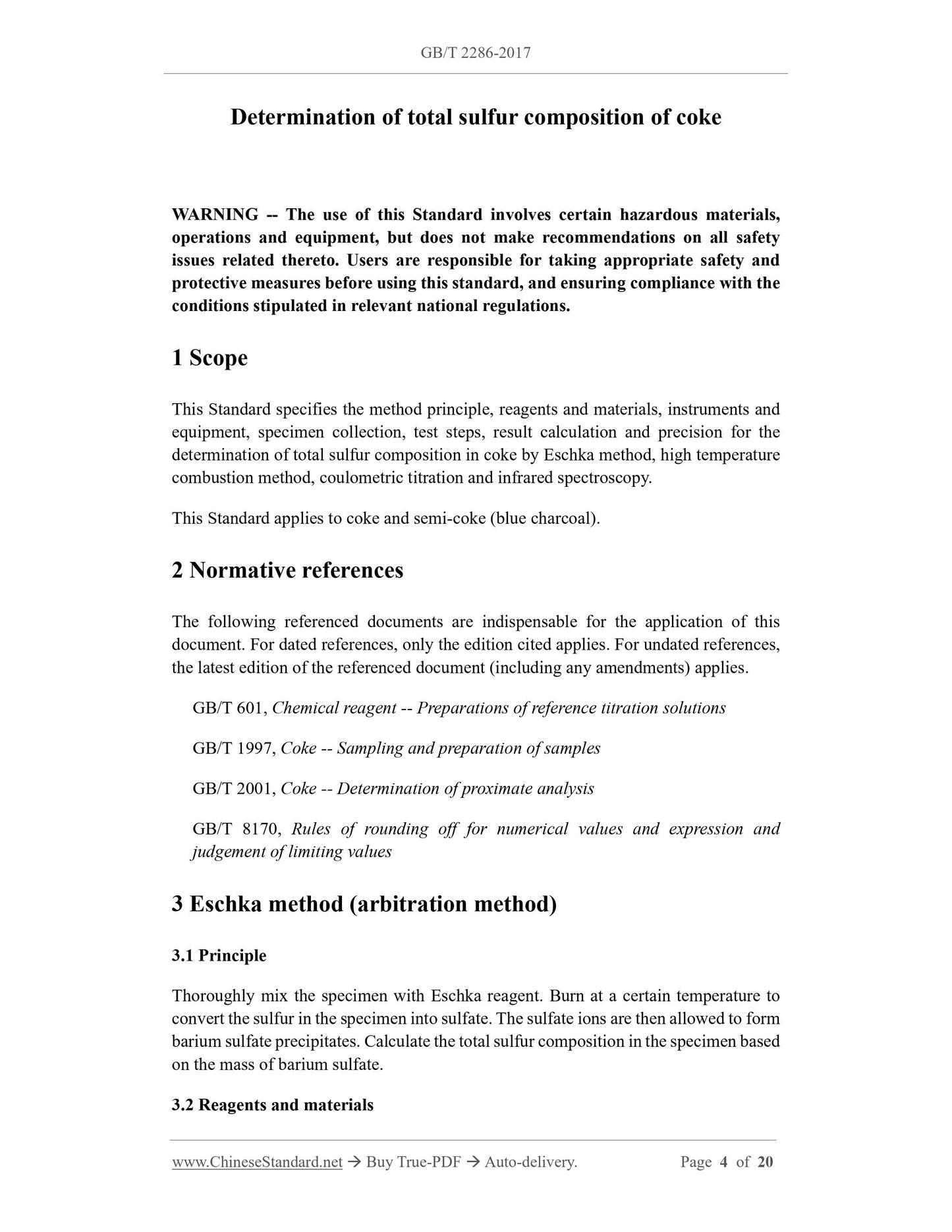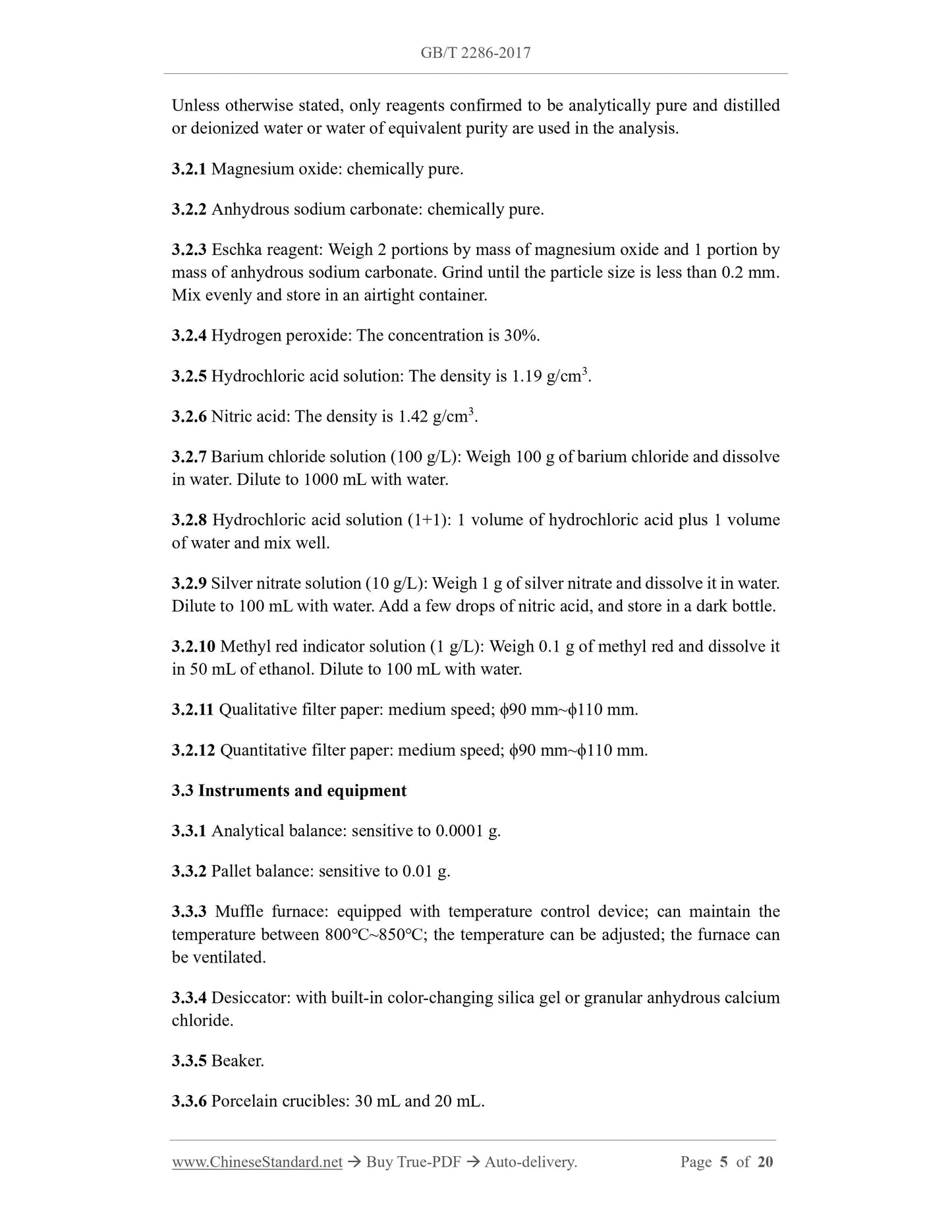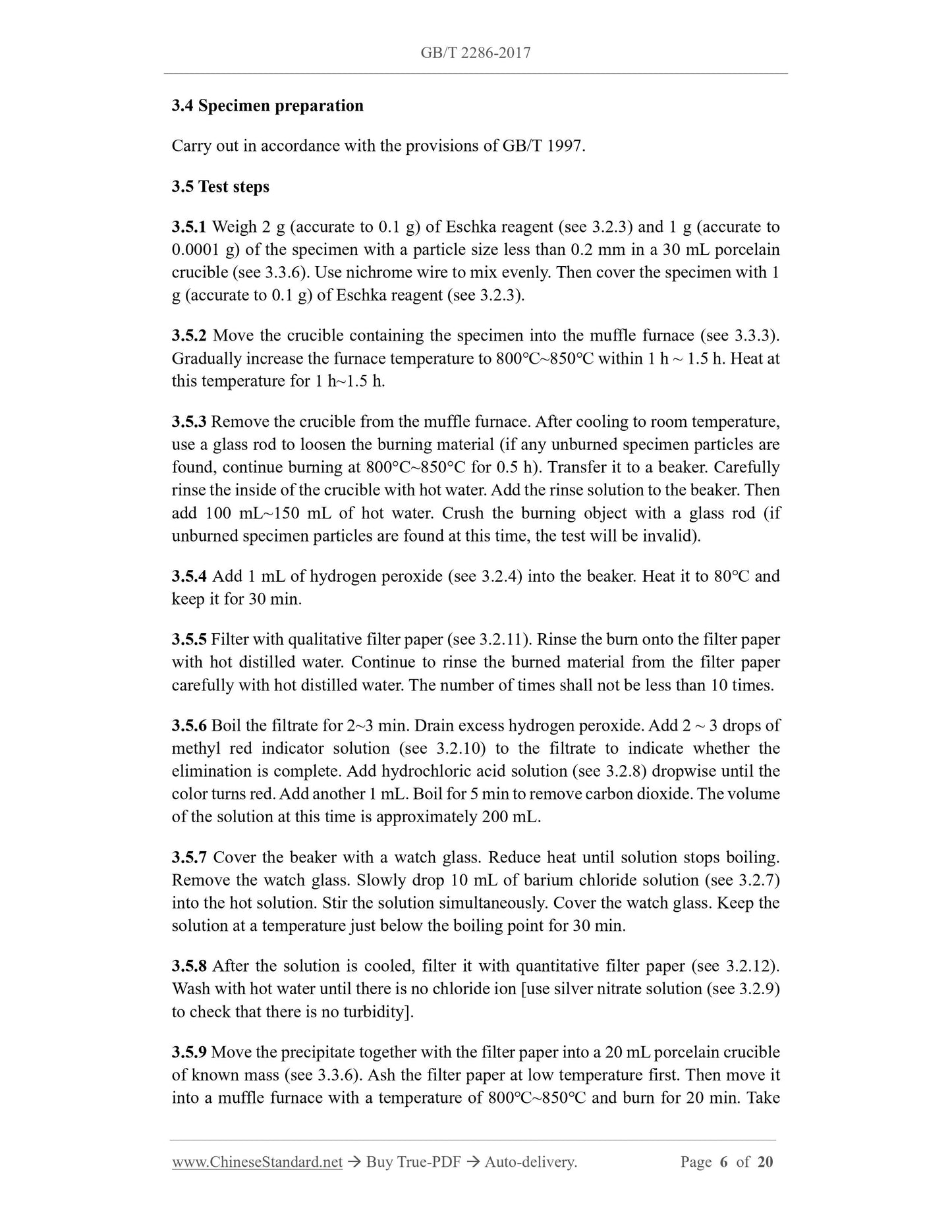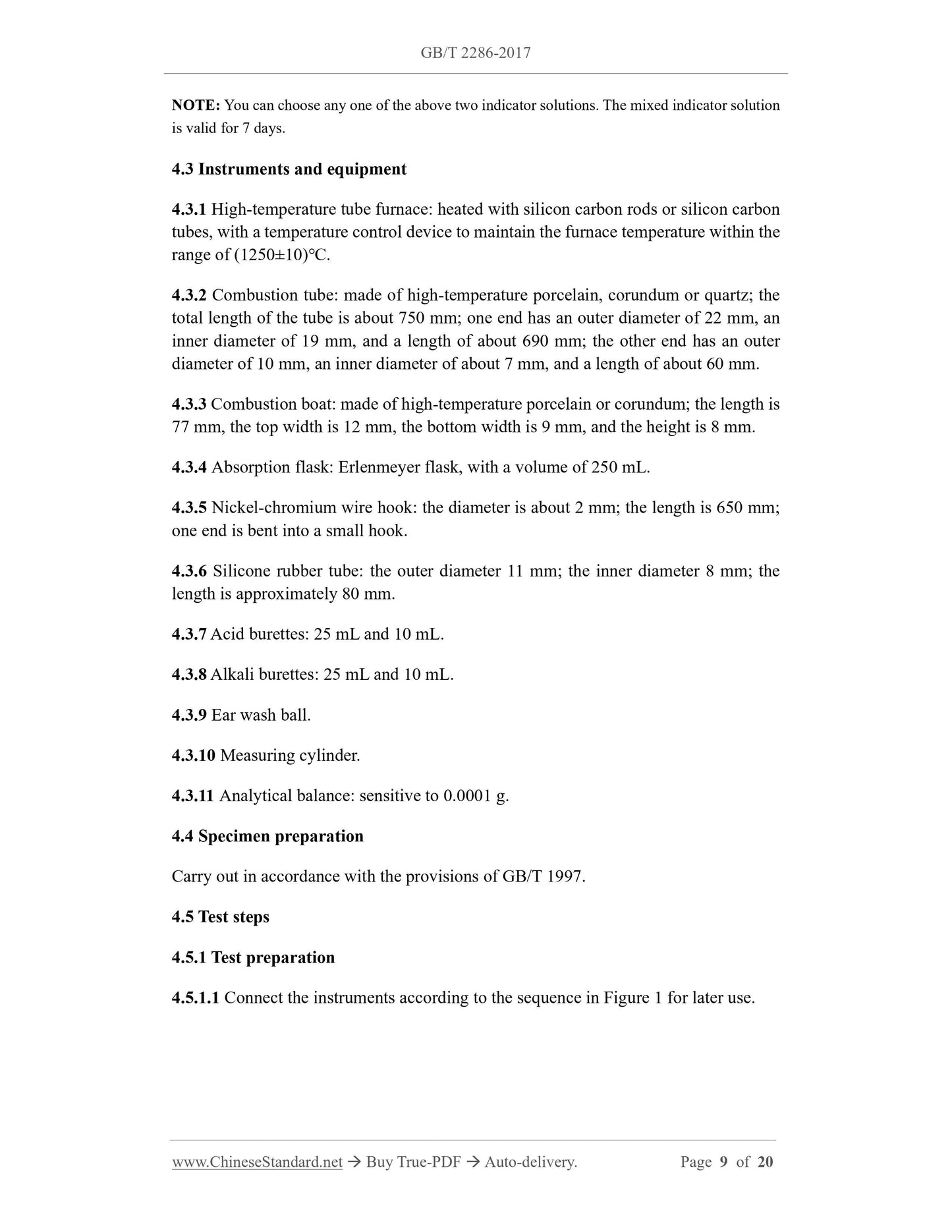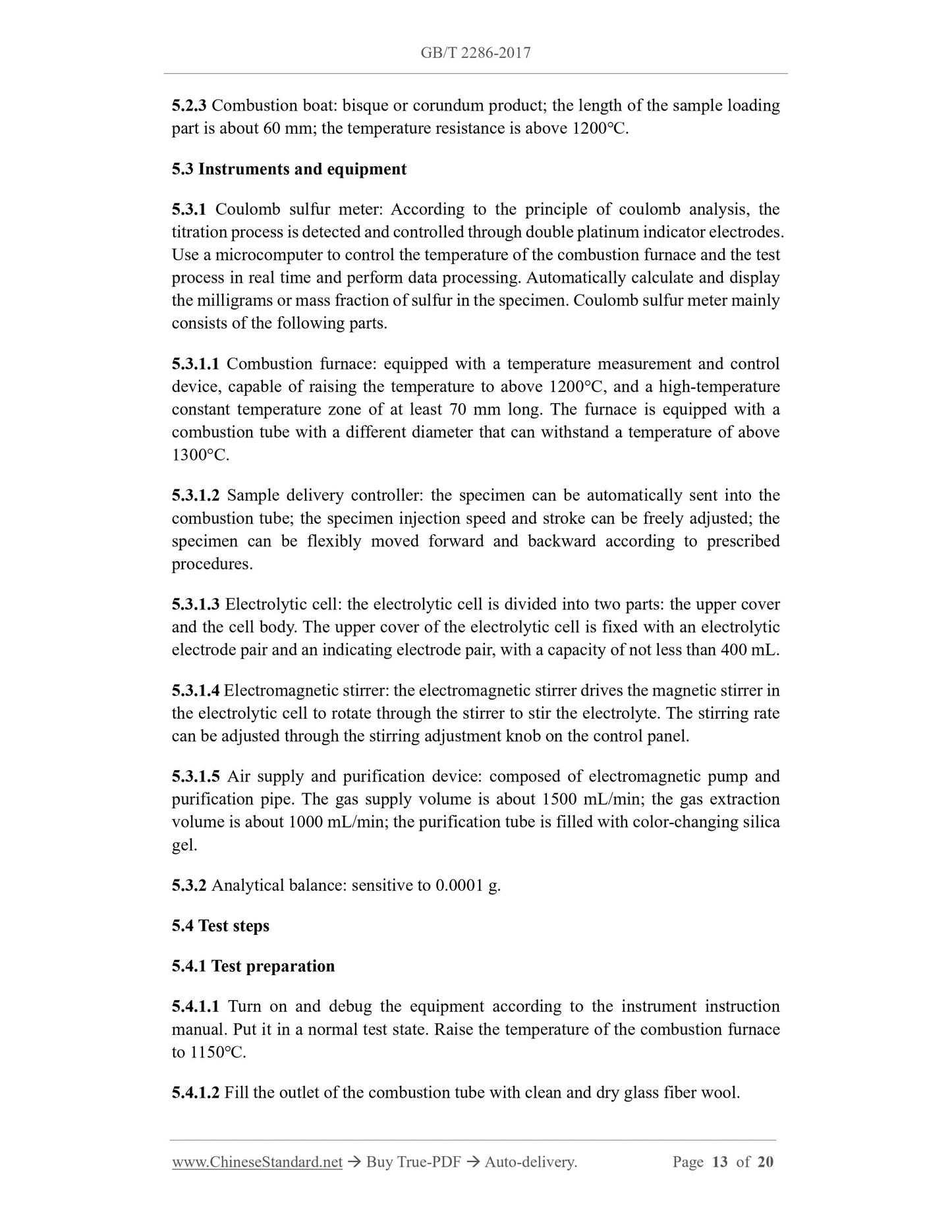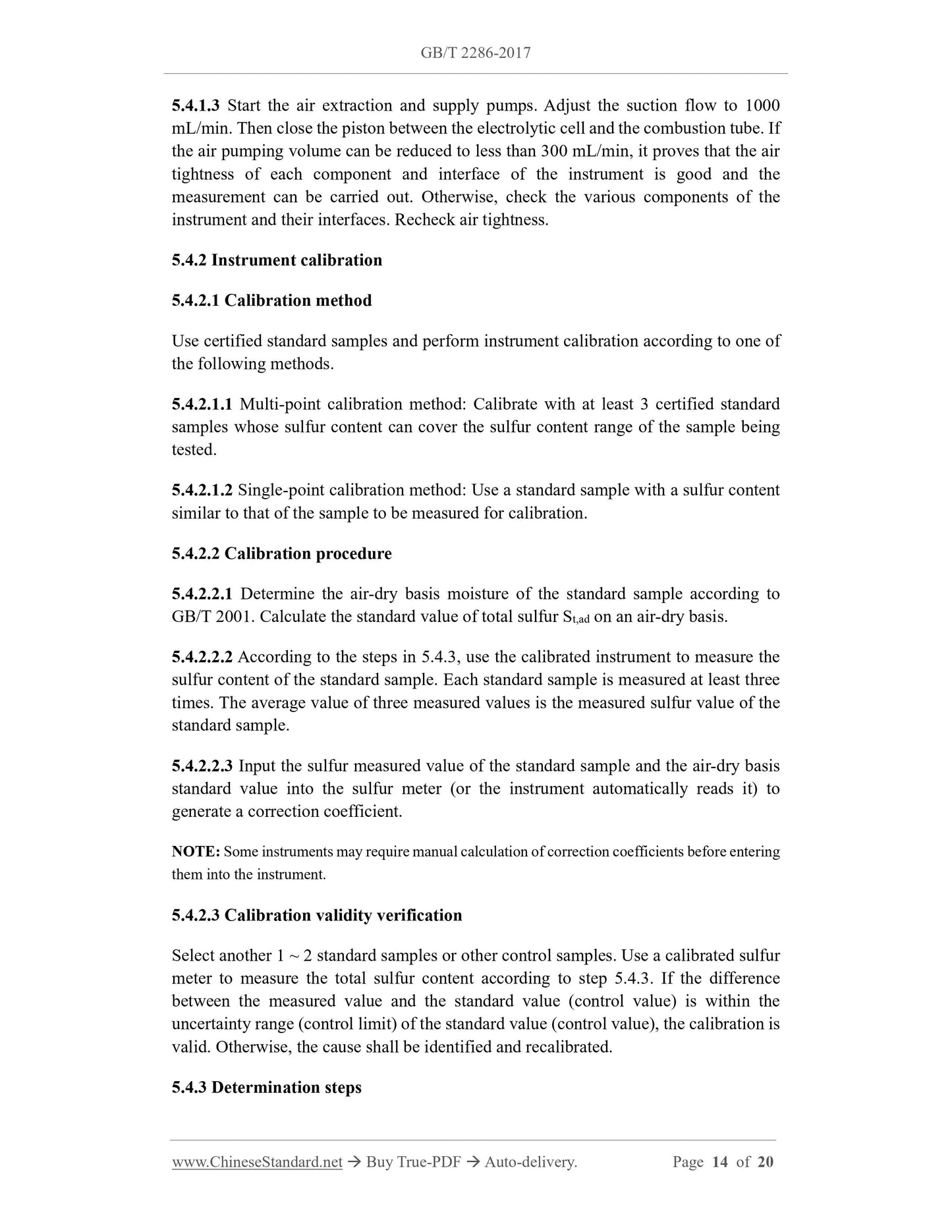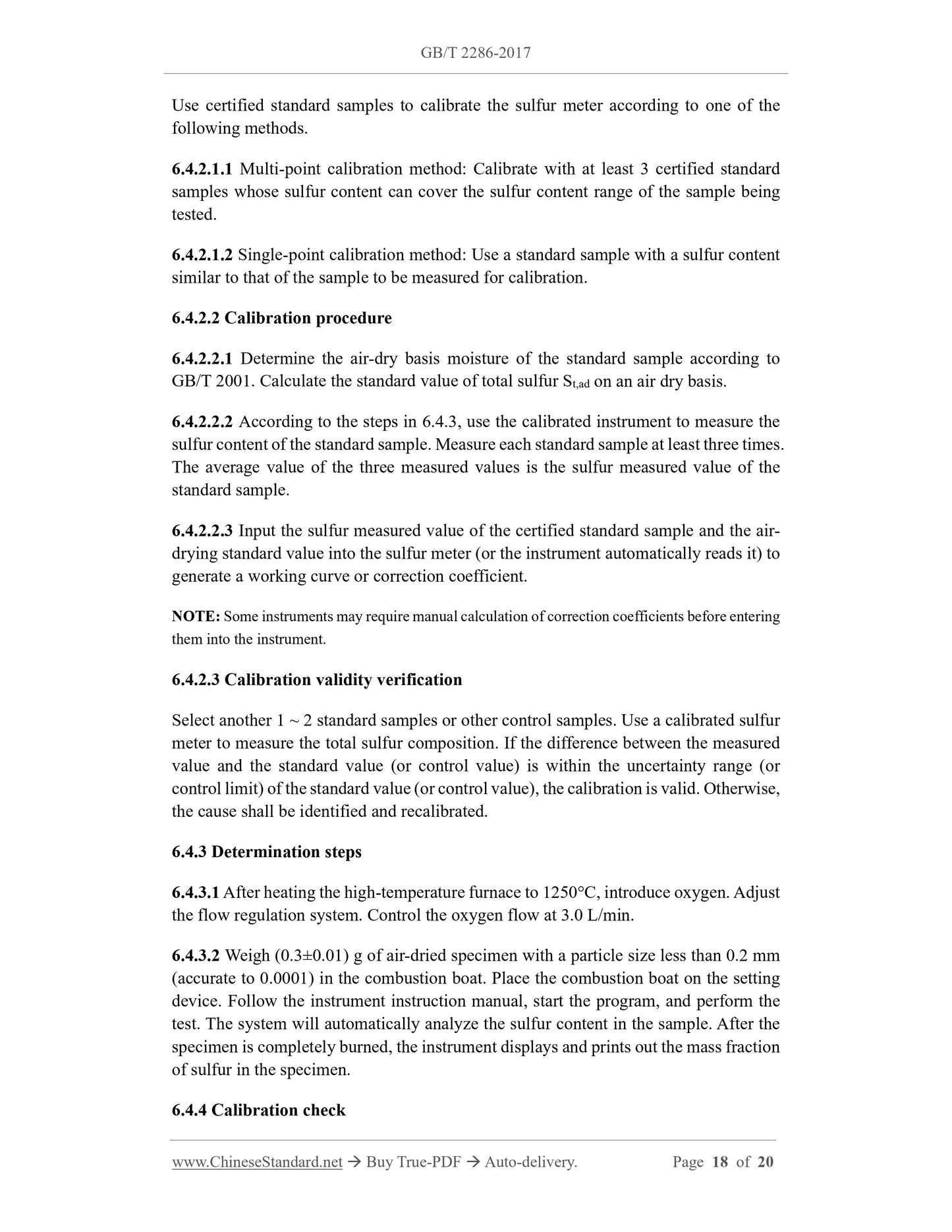1
/
of
9
www.ChineseStandard.us -- Field Test Asia Pte. Ltd.
GB/T 2286-2017 English PDF (GB/T2286-2017)
GB/T 2286-2017 English PDF (GB/T2286-2017)
Regular price
$225.00
Regular price
Sale price
$225.00
Unit price
/
per
Shipping calculated at checkout.
Couldn't load pickup availability
GB/T 2286-2017: Determination of total sulfur composition of coke
Delivery: 9 seconds. Download (& Email) true-PDF + Invoice.
Get Quotation: Click GB/T 2286-2017 (Self-service in 1-minute)
Historical versions (Master-website): GB/T 2286-2017
Preview True-PDF (Reload/Scroll-down if blank)
GB/T 2286-2017
GB
NATIONAL STANDARD OF THE
PEOPLE’S REPUBLIC OF CHINA
ICS 75.160.10
H 32
Replacing GB/T 2286-2008
Determination of total sulfur composition of coke
ISSUED ON: OCTOBER 14, 2017
IMPLEMENTED ON: MAY 01, 2018
Issued by: General Administration of Quality Supervision, Inspection and
Quarantine of the People's Republic of China;
Standardization Administration of the People's Republic of China.
Table of Contents
Foreword ... 3
1 Scope ... 4
2 Normative references ... 4
3 Eschka method (arbitration method) ... 4
4 High temperature combustion method ... 8
5 Coulometric titration method ... 12
6 Infrared spectroscopy method ... 16
7 Result expression ... 19
8 Test report ... 19
Determination of total sulfur composition of coke
WARNING -- The use of this Standard involves certain hazardous materials,
operations and equipment, but does not make recommendations on all safety
issues related thereto. Users are responsible for taking appropriate safety and
protective measures before using this standard, and ensuring compliance with the
conditions stipulated in relevant national regulations.
1 Scope
This Standard specifies the method principle, reagents and materials, instruments and
equipment, specimen collection, test steps, result calculation and precision for the
determination of total sulfur composition in coke by Eschka method, high temperature
combustion method, coulometric titration and infrared spectroscopy.
This Standard applies to coke and semi-coke (blue charcoal).
2 Normative references
The following referenced documents are indispensable for the application of this
document. For dated references, only the edition cited applies. For undated references,
the latest edition of the referenced document (including any amendments) applies.
GB/T 601, Chemical reagent -- Preparations of reference titration solutions
GB/T 1997, Coke -- Sampling and preparation of samples
GB/T 2001, Coke -- Determination of proximate analysis
GB/T 8170, Rules of rounding off for numerical values and expression and
judgement of limiting values
3 Eschka method (arbitration method)
3.1 Principle
Thoroughly mix the specimen with Eschka reagent. Burn at a certain temperature to
convert the sulfur in the specimen into sulfate. The sulfate ions are then allowed to form
barium sulfate precipitates. Calculate the total sulfur composition in the specimen based
on the mass of barium sulfate.
3.2 Reagents and materials
Unless otherwise stated, only reagents confirmed to be analytically pure and distilled
or deionized water or water of equivalent purity are used in the analysis.
3.2.1 Magnesium oxide: chemically pure.
3.2.2 Anhydrous sodium carbonate: chemically pure.
3.2.3 Eschka reagent: Weigh 2 portions by mass of magnesium oxide and 1 portion by
mass of anhydrous sodium carbonate. Grind until the particle size is less than 0.2 mm.
Mix evenly and store in an airtight container.
3.2.4 Hydrogen peroxide: The concentration is 30%.
3.2.5 Hydrochloric acid solution: The density is 1.19 g/cm3.
3.2.6 Nitric acid: The density is 1.42 g/cm3.
3.2.7 Barium chloride solution (100 g/L): Weigh 100 g of barium chloride and dissolve
in water. Dilute to 1000 mL with water.
3.2.8 Hydrochloric acid solution (1+1): 1 volume of hydrochloric acid plus 1 volume
of water and mix well.
3.2.9 Silver nitrate solution (10 g/L): Weigh 1 g of silver nitrate and dissolve it in water.
Dilute to 100 mL with water. Add a few drops of nitric acid, and store in a dark bottle.
3.2.10 Methyl red indicator solution (1 g/L): Weigh 0.1 g of methyl red and dissolve it
in 50 mL of ethanol. Dilute to 100 mL with water.
3.2.11 Qualitative filter paper: medium speed; ϕ90 mm~ϕ110 mm.
3.2.12 Quantitative filter paper: medium speed; ϕ90 mm~ϕ110 mm.
3.3 Instruments and equipment
3.3.1 Analytical balance: sensitive to 0.0001 g.
3.3.2 Pallet balance: sensitive to 0.01 g.
3.3.3 Muffle furnace: equipped with temperature control device; can maintain the
temperature between 800℃~850℃; the temperature can be adjusted; the furnace can
be ventilated.
3.3.4 Desiccator: with built-in color-changing silica gel or granular anhydrous calcium
chloride.
3.3.5 Beaker.
3.3.6 Porcelain crucibles: 30 mL and 20 mL.
3.4 Specimen preparation
Carry out in accordance with the provisions of GB/T 1997.
3.5 Test steps
3.5.1 Weigh 2 g (accurate to 0.1 g) of Eschka reagent (see 3.2.3) and 1 g (accurate to
0.0001 g) of the specimen with a particle size less than 0.2 mm in a 30 mL porcelain
crucible (see 3.3.6). Use nichrome wire to mix evenly. Then cover the specimen with 1
g (accurate to 0.1 g) of Eschka reagent (see 3.2.3).
3.5.2 Move the crucible containing the specimen into the muffle furnace (see 3.3.3).
Gradually increase the furnace temperature to 800℃~850℃ within 1 h ~ 1.5 h. Heat at
this temperature for 1 h~1.5 h.
3.5.3 Remove the crucible from the muffle furnace. After cooling to room temperature,
use a glass rod to loosen the burning material (if any unburned specimen particles are
found, continue burning at 800°C~850°C for 0.5 h). Transfer it to a beaker. Carefully
rinse the inside of the crucible with hot water. Add the rinse solution to the beaker. Then
add 100 mL~150 mL of hot water. Crush the burning object with a glass rod (if
unburned specimen particles are found at this time, the test will be invalid).
3.5.4 Add 1 mL of hydrogen peroxide (see 3.2.4) into the beaker. Heat it to 80℃ and
keep it for 30 min.
3.5.5 Filter with qualitative filter paper (see 3.2.11). Rinse the burn onto the filter paper
with hot distilled water. Continue to rinse the burned material from the filter paper
carefully with hot distilled water. The number of times shall not be less than 10 times.
3.5.6 Boil the filtrate for 2~3 min. Drain excess hydrogen peroxide. Add 2 ~ 3 drops of
methyl red indicator solution (see 3.2.10) to the filtrate to indicate whether the
elimination is complete. Add hydrochloric acid solution (see 3.2.8) dropwise until the
color turns red. Add another 1 mL. Boil for 5 min to remove carbon dioxide. The volume
of the solution at this time is approximately 200 mL.
3.5.7 Cover the beaker with a watch glass. Reduce heat until solution stops boiling.
Remove the watch glass. Slowly drop 10 mL of barium chloride solution (see 3.2.7)
into the hot solution. Stir the solution simultaneously. Cover the watch glass. Keep the
solution at a temperature just below the boiling point for 30 min.
3.5.8 After the solution is cooled, filter it with quantitative filter paper (see 3.2.12).
Wash with hot water until there is no chloride ion [use silver nitrate solution (see 3.2.9)
to check that there is no turbidity].
3.5.9 Move the precipitate together with the filter paper into a 20 mL porcelain crucible
of known mass (see 3.3.6). Ash the filter paper at low temperature first. Then move it
into a muffle furnace with a temperature of 800℃~850℃ and burn for 20 min. Take
NOTE: You can choose any one of the above two indicator solutions. The mixed indicator solution
is valid for 7 days.
4.3 Instruments and equipment
4.3.1 High-temperature tube furnace: heated with silicon carbon rods or silicon carbon
tubes, with a temperature control device to maintain the furnace temperature within the
range of (1250±10)℃.
4.3.2 Combustion tube: made of high-temperature porcelain, corundum or quartz; the
total length of the tube is about 750 mm; one end has an outer diameter of 22 mm, an
inner diameter of 19 mm, and a length of about 690 mm; the other end has an outer
diameter of 10 mm, an inner diameter of about 7 mm, and a length of about 60 mm.
4.3.3 Combustion boat: made of high-temperature porcelain or corundum; the length is
77 mm, the top width is 12 mm, the bottom width is 9 mm, and the height is 8 mm.
4.3.4 Absorption flask: Erlenmeyer flask, with a volume of 250 mL.
4.3.5 Nickel-chromium wire hook: the diameter is about 2 mm; the length is 650 mm;
one end is bent into a small hook.
4.3.6 Silicone rubber tube: the outer diameter 11 mm; the inner diameter 8 mm; the
length is approximately 80 mm.
4.3.7 Acid burettes: 25 mL and 10 mL.
4.3.8 Alkali burettes: 25 mL and 10 mL.
4.3.9 Ear wash ball.
4.3.10 Measuring cylinder.
4.3.11 Analytical balance: sensitive to 0.0001 g.
4.4 Specimen preparation
Carry out in accordance with the provisions of GB/T 1997.
4.5 Test steps
4.5.1 Test preparation
4.5.1.1 Connect the instruments according to the sequence in Figure 1 for later use.
5.2.3 Combustion boat: bisque or corundum product; the length of the sample loading
part is about 60 mm; the temperature resistance is above 1200℃.
5.3 Instruments and equipment
5.3.1 Coulomb sulfur meter: According to the principle of coulomb analysis, the
titration process is detected and controlled through double platinum indicator electrodes.
Use a microcomputer to control the temperature of the combustion furnace and the test
process in real time and perform data processing. Automatically calculate and display
the milligrams or mass fraction of sulfur in the specimen. Coulomb sulfur meter mainly
consists of the following parts.
5.3.1.1 Combustion furnace: equipped with a temperature measurement and control
device, capable of raising the temperature to above 1200°C, and a high-temperature
constant temperature zone of at least 70 mm long. The furnace is equipped with a
combustion tube with a different diameter that can withstand a temperature of above
1300°C.
5.3.1.2 Sample delivery controller: the specimen can be automatically sent into the
combustion tube; the specimen injection speed and stroke can be freely adjusted; the
specimen can be flexibly moved forward and backward according to prescribed
procedures.
5.3.1.3 Electrolytic cell: the electrolytic cell is divided into two parts: the upper cover
and the cell body. The upper cover of the electrolytic cell is fixed with an electrolytic
electrode pair and an indicating electrode pair, with a capacity of not less than 400 mL.
5.3.1.4 Electromagnetic stirrer: the electromagnetic stirrer drives the magnetic stirrer in
the electrolytic cell to rotate through the stirrer to stir the electrolyte. The stirring rate
can be adjusted through the stirring adjustment knob on the control panel.
5.3.1.5 Air supply and purification device: composed of electromagnetic pump and
purification pipe. The gas supply volume is about 1500 mL/min; the gas extraction
volume is about 1000 mL/min; the purification tube is filled with color-changing silica
gel.
5.3.2 Analytical balance: sensitive to 0.0001 g.
5.4 Test steps
5.4.1 Test preparation
5.4.1.1 Turn on and debug the equipment according to the instrument instruction
manual. Put it in a normal test state. Raise the temperature of the combustion furnace
to 1150℃.
5.4.1.2 Fill the outlet of the combustion tube with clean and dry glass fiber wool.
5.4.1.3 Start the air extraction and supply pumps. Adjust the suction flow to 1000
mL/min. Then close the piston between the electrolytic cell and the combustion tube. If
the air pumping volume can be reduced to less than 300 mL/min, it proves that the air
tightness of each component and interface of the instrument is good and the
measurement can be carried out. Otherwise, check the various components of the
instrument and their interfaces. Recheck air tightness.
5.4.2 Instrument calibration
5.4.2.1 Calibration method
Use certified standard samples and perform instrument calibration according to one of
the following methods.
5.4.2.1.1 Multi-point calibration method: Calibrate with at least 3 certified standard
samples whose sulfur content can cover the sulfur content range of the sample being
tested.
5.4.2.1.2 Single-point calibration method: Use a standard sample with a sulfur content
similar to that of the sample to be measured for calibration.
5.4.2.2 Calibration procedure
5.4.2.2.1 Determine the air-dry basis moisture of the standard sample according to
GB/T 2001. Calculate the standard value of total sulfur St,ad on an air-dry basis.
5.4.2.2.2 According to the steps in 5.4.3, use the calibrated instrument to measure the
sulfur content of the standard sample. Each standard sample is measured at least three
times. The average value of three measured values is the measured sulfur value of the
standard sample.
5.4.2.2.3 Input the sulfur measured value of the standard sample and the air-dry basis
standard value into the sulfur meter (or the instrument automatically reads it) to
generate a correction coefficient.
NOTE: Some instruments may require manual calculation of correction coefficients before entering
them into the instrument.
5.4.2.3 Calibration validity verification
Select another 1 ~ 2 standard samples or other control samples. Use a calibrated sulfur
meter to measure the total sulfur content according to step 5.4.3. If the difference
between the measured value and the standard value (control value) is within the
uncertainty range (control limit) of the standard value (control value), the calibration is
valid. Otherwise, the cause shall be identified and recalibrated.
5.4.3 Determination steps
Use certified standard samples to calibrate the sulfur meter according to one of the
following methods.
6.4.2.1.1 Multi-point calibration method: Calibrate with at least 3 certified standard
samples whose sulfur content can cover the sulfur content range of the sample being
tested.
6.4.2.1.2 Single-point calibration method: Use a standard sample with a sulfur content
similar to that of the sample to be measured for calibration.
6.4.2.2 Calibration procedure
6.4.2.2.1 Determine the air-dry basis moisture of the standard sample according to
GB/T 2001. Calculate the standard value of total sulfur St,ad on an air dry basis.
6.4.2.2.2 According to the steps in 6.4.3, use the calibrated instrument to measure the
sulfur content of the standard sample. Measure each standard sample at least three times.
The average value of the three measured values...
Delivery: 9 seconds. Download (& Email) true-PDF + Invoice.
Get Quotation: Click GB/T 2286-2017 (Self-service in 1-minute)
Historical versions (Master-website): GB/T 2286-2017
Preview True-PDF (Reload/Scroll-down if blank)
GB/T 2286-2017
GB
NATIONAL STANDARD OF THE
PEOPLE’S REPUBLIC OF CHINA
ICS 75.160.10
H 32
Replacing GB/T 2286-2008
Determination of total sulfur composition of coke
ISSUED ON: OCTOBER 14, 2017
IMPLEMENTED ON: MAY 01, 2018
Issued by: General Administration of Quality Supervision, Inspection and
Quarantine of the People's Republic of China;
Standardization Administration of the People's Republic of China.
Table of Contents
Foreword ... 3
1 Scope ... 4
2 Normative references ... 4
3 Eschka method (arbitration method) ... 4
4 High temperature combustion method ... 8
5 Coulometric titration method ... 12
6 Infrared spectroscopy method ... 16
7 Result expression ... 19
8 Test report ... 19
Determination of total sulfur composition of coke
WARNING -- The use of this Standard involves certain hazardous materials,
operations and equipment, but does not make recommendations on all safety
issues related thereto. Users are responsible for taking appropriate safety and
protective measures before using this standard, and ensuring compliance with the
conditions stipulated in relevant national regulations.
1 Scope
This Standard specifies the method principle, reagents and materials, instruments and
equipment, specimen collection, test steps, result calculation and precision for the
determination of total sulfur composition in coke by Eschka method, high temperature
combustion method, coulometric titration and infrared spectroscopy.
This Standard applies to coke and semi-coke (blue charcoal).
2 Normative references
The following referenced documents are indispensable for the application of this
document. For dated references, only the edition cited applies. For undated references,
the latest edition of the referenced document (including any amendments) applies.
GB/T 601, Chemical reagent -- Preparations of reference titration solutions
GB/T 1997, Coke -- Sampling and preparation of samples
GB/T 2001, Coke -- Determination of proximate analysis
GB/T 8170, Rules of rounding off for numerical values and expression and
judgement of limiting values
3 Eschka method (arbitration method)
3.1 Principle
Thoroughly mix the specimen with Eschka reagent. Burn at a certain temperature to
convert the sulfur in the specimen into sulfate. The sulfate ions are then allowed to form
barium sulfate precipitates. Calculate the total sulfur composition in the specimen based
on the mass of barium sulfate.
3.2 Reagents and materials
Unless otherwise stated, only reagents confirmed to be analytically pure and distilled
or deionized water or water of equivalent purity are used in the analysis.
3.2.1 Magnesium oxide: chemically pure.
3.2.2 Anhydrous sodium carbonate: chemically pure.
3.2.3 Eschka reagent: Weigh 2 portions by mass of magnesium oxide and 1 portion by
mass of anhydrous sodium carbonate. Grind until the particle size is less than 0.2 mm.
Mix evenly and store in an airtight container.
3.2.4 Hydrogen peroxide: The concentration is 30%.
3.2.5 Hydrochloric acid solution: The density is 1.19 g/cm3.
3.2.6 Nitric acid: The density is 1.42 g/cm3.
3.2.7 Barium chloride solution (100 g/L): Weigh 100 g of barium chloride and dissolve
in water. Dilute to 1000 mL with water.
3.2.8 Hydrochloric acid solution (1+1): 1 volume of hydrochloric acid plus 1 volume
of water and mix well.
3.2.9 Silver nitrate solution (10 g/L): Weigh 1 g of silver nitrate and dissolve it in water.
Dilute to 100 mL with water. Add a few drops of nitric acid, and store in a dark bottle.
3.2.10 Methyl red indicator solution (1 g/L): Weigh 0.1 g of methyl red and dissolve it
in 50 mL of ethanol. Dilute to 100 mL with water.
3.2.11 Qualitative filter paper: medium speed; ϕ90 mm~ϕ110 mm.
3.2.12 Quantitative filter paper: medium speed; ϕ90 mm~ϕ110 mm.
3.3 Instruments and equipment
3.3.1 Analytical balance: sensitive to 0.0001 g.
3.3.2 Pallet balance: sensitive to 0.01 g.
3.3.3 Muffle furnace: equipped with temperature control device; can maintain the
temperature between 800℃~850℃; the temperature can be adjusted; the furnace can
be ventilated.
3.3.4 Desiccator: with built-in color-changing silica gel or granular anhydrous calcium
chloride.
3.3.5 Beaker.
3.3.6 Porcelain crucibles: 30 mL and 20 mL.
3.4 Specimen preparation
Carry out in accordance with the provisions of GB/T 1997.
3.5 Test steps
3.5.1 Weigh 2 g (accurate to 0.1 g) of Eschka reagent (see 3.2.3) and 1 g (accurate to
0.0001 g) of the specimen with a particle size less than 0.2 mm in a 30 mL porcelain
crucible (see 3.3.6). Use nichrome wire to mix evenly. Then cover the specimen with 1
g (accurate to 0.1 g) of Eschka reagent (see 3.2.3).
3.5.2 Move the crucible containing the specimen into the muffle furnace (see 3.3.3).
Gradually increase the furnace temperature to 800℃~850℃ within 1 h ~ 1.5 h. Heat at
this temperature for 1 h~1.5 h.
3.5.3 Remove the crucible from the muffle furnace. After cooling to room temperature,
use a glass rod to loosen the burning material (if any unburned specimen particles are
found, continue burning at 800°C~850°C for 0.5 h). Transfer it to a beaker. Carefully
rinse the inside of the crucible with hot water. Add the rinse solution to the beaker. Then
add 100 mL~150 mL of hot water. Crush the burning object with a glass rod (if
unburned specimen particles are found at this time, the test will be invalid).
3.5.4 Add 1 mL of hydrogen peroxide (see 3.2.4) into the beaker. Heat it to 80℃ and
keep it for 30 min.
3.5.5 Filter with qualitative filter paper (see 3.2.11). Rinse the burn onto the filter paper
with hot distilled water. Continue to rinse the burned material from the filter paper
carefully with hot distilled water. The number of times shall not be less than 10 times.
3.5.6 Boil the filtrate for 2~3 min. Drain excess hydrogen peroxide. Add 2 ~ 3 drops of
methyl red indicator solution (see 3.2.10) to the filtrate to indicate whether the
elimination is complete. Add hydrochloric acid solution (see 3.2.8) dropwise until the
color turns red. Add another 1 mL. Boil for 5 min to remove carbon dioxide. The volume
of the solution at this time is approximately 200 mL.
3.5.7 Cover the beaker with a watch glass. Reduce heat until solution stops boiling.
Remove the watch glass. Slowly drop 10 mL of barium chloride solution (see 3.2.7)
into the hot solution. Stir the solution simultaneously. Cover the watch glass. Keep the
solution at a temperature just below the boiling point for 30 min.
3.5.8 After the solution is cooled, filter it with quantitative filter paper (see 3.2.12).
Wash with hot water until there is no chloride ion [use silver nitrate solution (see 3.2.9)
to check that there is no turbidity].
3.5.9 Move the precipitate together with the filter paper into a 20 mL porcelain crucible
of known mass (see 3.3.6). Ash the filter paper at low temperature first. Then move it
into a muffle furnace with a temperature of 800℃~850℃ and burn for 20 min. Take
NOTE: You can choose any one of the above two indicator solutions. The mixed indicator solution
is valid for 7 days.
4.3 Instruments and equipment
4.3.1 High-temperature tube furnace: heated with silicon carbon rods or silicon carbon
tubes, with a temperature control device to maintain the furnace temperature within the
range of (1250±10)℃.
4.3.2 Combustion tube: made of high-temperature porcelain, corundum or quartz; the
total length of the tube is about 750 mm; one end has an outer diameter of 22 mm, an
inner diameter of 19 mm, and a length of about 690 mm; the other end has an outer
diameter of 10 mm, an inner diameter of about 7 mm, and a length of about 60 mm.
4.3.3 Combustion boat: made of high-temperature porcelain or corundum; the length is
77 mm, the top width is 12 mm, the bottom width is 9 mm, and the height is 8 mm.
4.3.4 Absorption flask: Erlenmeyer flask, with a volume of 250 mL.
4.3.5 Nickel-chromium wire hook: the diameter is about 2 mm; the length is 650 mm;
one end is bent into a small hook.
4.3.6 Silicone rubber tube: the outer diameter 11 mm; the inner diameter 8 mm; the
length is approximately 80 mm.
4.3.7 Acid burettes: 25 mL and 10 mL.
4.3.8 Alkali burettes: 25 mL and 10 mL.
4.3.9 Ear wash ball.
4.3.10 Measuring cylinder.
4.3.11 Analytical balance: sensitive to 0.0001 g.
4.4 Specimen preparation
Carry out in accordance with the provisions of GB/T 1997.
4.5 Test steps
4.5.1 Test preparation
4.5.1.1 Connect the instruments according to the sequence in Figure 1 for later use.
5.2.3 Combustion boat: bisque or corundum product; the length of the sample loading
part is about 60 mm; the temperature resistance is above 1200℃.
5.3 Instruments and equipment
5.3.1 Coulomb sulfur meter: According to the principle of coulomb analysis, the
titration process is detected and controlled through double platinum indicator electrodes.
Use a microcomputer to control the temperature of the combustion furnace and the test
process in real time and perform data processing. Automatically calculate and display
the milligrams or mass fraction of sulfur in the specimen. Coulomb sulfur meter mainly
consists of the following parts.
5.3.1.1 Combustion furnace: equipped with a temperature measurement and control
device, capable of raising the temperature to above 1200°C, and a high-temperature
constant temperature zone of at least 70 mm long. The furnace is equipped with a
combustion tube with a different diameter that can withstand a temperature of above
1300°C.
5.3.1.2 Sample delivery controller: the specimen can be automatically sent into the
combustion tube; the specimen injection speed and stroke can be freely adjusted; the
specimen can be flexibly moved forward and backward according to prescribed
procedures.
5.3.1.3 Electrolytic cell: the electrolytic cell is divided into two parts: the upper cover
and the cell body. The upper cover of the electrolytic cell is fixed with an electrolytic
electrode pair and an indicating electrode pair, with a capacity of not less than 400 mL.
5.3.1.4 Electromagnetic stirrer: the electromagnetic stirrer drives the magnetic stirrer in
the electrolytic cell to rotate through the stirrer to stir the electrolyte. The stirring rate
can be adjusted through the stirring adjustment knob on the control panel.
5.3.1.5 Air supply and purification device: composed of electromagnetic pump and
purification pipe. The gas supply volume is about 1500 mL/min; the gas extraction
volume is about 1000 mL/min; the purification tube is filled with color-changing silica
gel.
5.3.2 Analytical balance: sensitive to 0.0001 g.
5.4 Test steps
5.4.1 Test preparation
5.4.1.1 Turn on and debug the equipment according to the instrument instruction
manual. Put it in a normal test state. Raise the temperature of the combustion furnace
to 1150℃.
5.4.1.2 Fill the outlet of the combustion tube with clean and dry glass fiber wool.
5.4.1.3 Start the air extraction and supply pumps. Adjust the suction flow to 1000
mL/min. Then close the piston between the electrolytic cell and the combustion tube. If
the air pumping volume can be reduced to less than 300 mL/min, it proves that the air
tightness of each component and interface of the instrument is good and the
measurement can be carried out. Otherwise, check the various components of the
instrument and their interfaces. Recheck air tightness.
5.4.2 Instrument calibration
5.4.2.1 Calibration method
Use certified standard samples and perform instrument calibration according to one of
the following methods.
5.4.2.1.1 Multi-point calibration method: Calibrate with at least 3 certified standard
samples whose sulfur content can cover the sulfur content range of the sample being
tested.
5.4.2.1.2 Single-point calibration method: Use a standard sample with a sulfur content
similar to that of the sample to be measured for calibration.
5.4.2.2 Calibration procedure
5.4.2.2.1 Determine the air-dry basis moisture of the standard sample according to
GB/T 2001. Calculate the standard value of total sulfur St,ad on an air-dry basis.
5.4.2.2.2 According to the steps in 5.4.3, use the calibrated instrument to measure the
sulfur content of the standard sample. Each standard sample is measured at least three
times. The average value of three measured values is the measured sulfur value of the
standard sample.
5.4.2.2.3 Input the sulfur measured value of the standard sample and the air-dry basis
standard value into the sulfur meter (or the instrument automatically reads it) to
generate a correction coefficient.
NOTE: Some instruments may require manual calculation of correction coefficients before entering
them into the instrument.
5.4.2.3 Calibration validity verification
Select another 1 ~ 2 standard samples or other control samples. Use a calibrated sulfur
meter to measure the total sulfur content according to step 5.4.3. If the difference
between the measured value and the standard value (control value) is within the
uncertainty range (control limit) of the standard value (control value), the calibration is
valid. Otherwise, the cause shall be identified and recalibrated.
5.4.3 Determination steps
Use certified standard samples to calibrate the sulfur meter according to one of the
following methods.
6.4.2.1.1 Multi-point calibration method: Calibrate with at least 3 certified standard
samples whose sulfur content can cover the sulfur content range of the sample being
tested.
6.4.2.1.2 Single-point calibration method: Use a standard sample with a sulfur content
similar to that of the sample to be measured for calibration.
6.4.2.2 Calibration procedure
6.4.2.2.1 Determine the air-dry basis moisture of the standard sample according to
GB/T 2001. Calculate the standard value of total sulfur St,ad on an air dry basis.
6.4.2.2.2 According to the steps in 6.4.3, use the calibrated instrument to measure the
sulfur content of the standard sample. Measure each standard sample at least three times.
The average value of the three measured values...
Share
